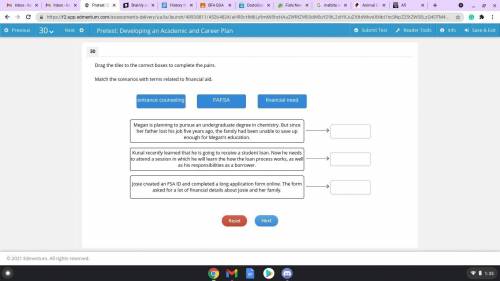
Business, 06.02.2021 21:40 hgghukghj1814
Drag the tiles to the correct boxes to complete the pairs. Match the scenarios with terms related to financial aid.


Answers: 3


Other questions on the subject: Business

Business, 22.06.2019 03:50, raieliz1414
Suppose that a worker in agland can produce either 10 units of organic grain or 2 units of incense per year, and a worker in zenland can produce either 5 units of organic grain or 15 units of incense per year. there are 20 workers in agland and 10 workers in zenland. currently the two countries do not trade. agland produces and consumes 100 units of grain and 20 units of incense per year. zenland produces and consumes 50 units of grain and no incense per year. if each country made the decision to specialize in producing the good in which it has a comparative advantage, then the combined yearly output of the two countries would increase by a. 30 units of grain and 100 units of incense. b. 30 units of grain and 150 units of incense. c. 50 units of grain and 90 units of incense. d. 50 units of grain and 130 units of ince
Answers: 1

Business, 22.06.2019 05:10, russboys3
The total value of your portfolio is $10,000: $3,000 of it is invested in stock a and the remainder invested in stock b. stock a has a beta of 0.8; stock b has a beta of 1.2. the risk premium on the market portfolio is 8%; the risk-free rate is 2%. additional information on stocks a and b is provided below. return in each state state probability of state stock a stock b excellent 15% 15% 5% normal 50% 9% 7% poor 35% -15% 10% what are each stock’s expected return and the standard deviation? what are the expected return and the standard deviation of your portfolio? what is the beta of your portfolio? using capm, what is the expected return on the portfolio? given your answer above, would you buy, sell, or hold the portfolio?
Answers: 1

Business, 22.06.2019 07:30, taridunkley724
Hours to produce one unit worker hours to produce yarn country a 8 hours country b 4 hours worker hours to produce fabric counrty a 12 hours country b 13 hours additional worker hours to produce fabric instead of yarn country a ? country b? which of the follow is true of the trade relationship between country a and country b? country a has an absolute advantage in producing yarn and fabric country b has an absolute advantage in producing yarn and fabric country b has a comparative advantage to country a in producing fabric country a has a comparative advantage to country b in producing fabric
Answers: 2

Business, 22.06.2019 07:50, pattydixon6
The questions of economics address which of the following ? check all that apply
Answers: 3
You know the right answer?
Drag the tiles to the correct boxes to complete the pairs. Match the scenarios with terms related to...
Questions in other subjects:






Advanced Placement (AP), 05.01.2020 06:31


Mathematics, 05.01.2020 06:31





